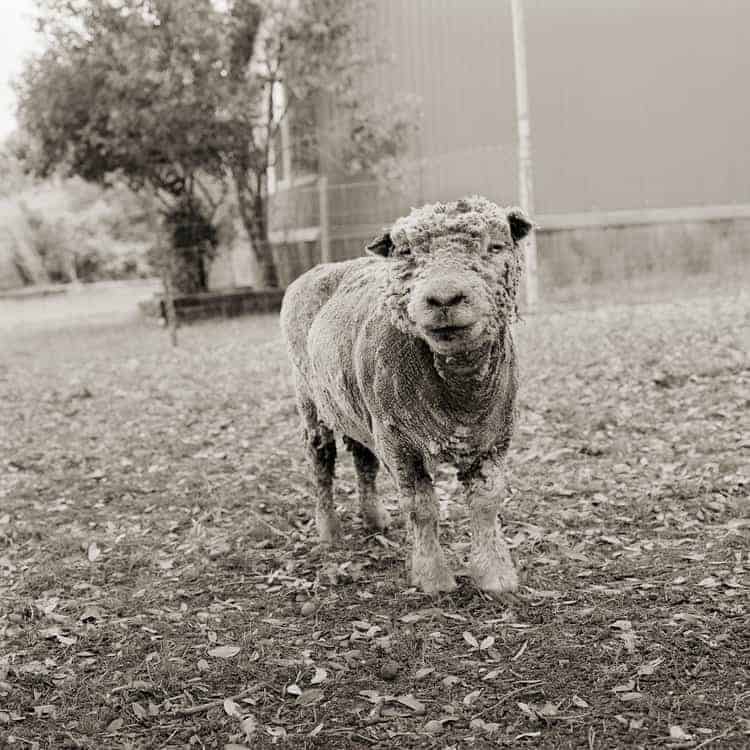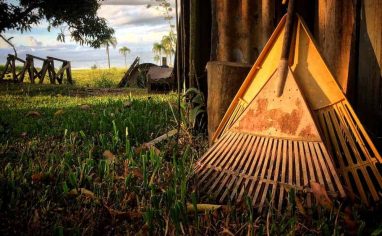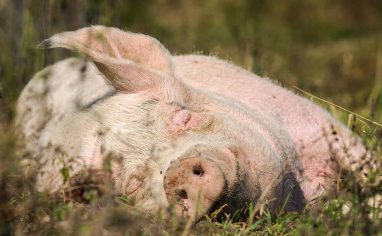
This resource has been updated as part of the veterinary review process. It was originally published on April 29, 2018.

Veterinary Review Initiative
This resource has been reviewed for accuracy and clarity by a qualified Doctor of Veterinary Medicine with farmed animal sanctuaryAn animal sanctuary that primarily cares for rescued animals that were farmed by humans. experience as of September 2023. Check out more information on our Veterinary Review Initiative here!
With proper care, sheep have the opportunity to live long lives. The average life expectancy for domesticatedAdapted over time (as by selective breeding) from a wild or natural state to life in close association with and to the benefit of humans sheep ranges from 10-12 years, with some individuals living past the age of 20! There are many factors that affect an individual’s expected lifespan, including some that are beyond a caregiver’s control such as their breed, genetics, and health status upon arrival, but their environment, as well as the nutrition and care they receive after rescue factor in as well. In addition to having an impact on their life expectancy, these elements of care also affect their quality of life and can help them thrive in their old age!
Health Care Considerations For Older Sheep
Thoughtful observation, routine health checks, and regular veterinary care are imperative for all residents, but you may find that older residents benefit from more frequent assessment and closer observation than they did when they were younger. This can help you catch and respond to issues before they progress to more serious situations. Some conditions, such as mobility issues, parasitism, and dental disease, tend to be more common in older sheep, though these are certainly not the only conditions that can affect older residents (and these conditions are not exclusive to older residents). Additionally, individuals who have chronic, progressive diseases (such as ovine progressive pneumonia) are likely to show signs of worsening condition as they age. By keeping a closer eye on older residents, you’ll be better able to catch signs of new or worsening conditions as soon as possible!
Daily Observation And Routine Health Checks
During daily observation and routine health checks, you should watch closely for any signs of concern, but when it comes to older residents, there are a few areas that may warrant extra attention.
Watch For Signs Of Arthritis And Related Issues
First, because osteoarthritis is common in elderly animals, and because ovine progressive pneumonia (OPP) can manifest as a progressive, chronic polyarthritis/polysynovitis, it’s important to closely monitor older residents for signs of lameness, changes in gaitA specific way of moving and the rhythmic patterns of hooves and legs. Gaits are natural (walking, trotting, galloping) or acquired meaning humans have had a hand in changing their gaits for "sport"., swelling of joints, or pain. Be sure to bring any concerns to your veterinarian so they can determine the cause and the best course of action. Proper pain management is imperative for individuals with painful conditions, and we’ll talk more about this below.
Individuals with arthritis may develop issues secondary to their mobility issues. If residents spend time “knee-walking,” in addition to working closely with your veterinarian, you’ll want to keep a close eye on their carpi (often referred to as the “front knees”) for abrasions and developing pressure sores. If an individual with arthritis has started to spend more time lying down, it’s important to monitor them for pressure sores, particularly on their keel and around their stifles. Pressure sores can be difficult to manage once they develop, particularly if the cause is a chronic condition, so prevention is key.
If a female sheep, particularly a woolen sheep, is no longer fully squatting when urinating due to arthritis, they will be more likely to urinate on themselves, which could result in urine scald or, in the warmer months, fly strike. These individuals may need to have the area under their vulva, and possibly portions of their back legs, regularly shaved and cleaned to prevent painful scald and fly strike. In some cases, you may also need to apply a barrier cream to help protect skin and/or a fly repellent, as recommended by your veterinarian.
Make Adjustments To Their Hoof Care Schedule As Needed
Individuals who bear weight unevenly, who knee-walk, or who are less active than they previously were may need some or all of their hooves trimmed more often than they previously did. If you find that an individual’s hooves are becoming too overgrown between regularly scheduled hoof trimming, you’ll need to put the individual on their own more frequent hoof trimming schedule. Whether they require more frequent hoof trimming or not, you may find that because of the strain and joint flexion involved in hoof trimming while in a standing position, some older individuals may benefit from being “pre-medicated” with pain medication even if they don’t typically require analgesics for arthritis. This must be done in consultation with your veterinarian to determine if it is appropriate, but some sanctuaries have found that administering a non-steroidal anti-inflammatory drug (NSAID) for a few days prior to using standing restraint for hoof trimming can make the process easier on the individual and can prevent lameness afterwards.
Closely Monitor Their Weight
It’s also very important to pay attention to your residents’ weight. It is not uncommon for elderly sheep to lose weight, which could be due to various issues such as dental disease, an underlying health condition (such as OPP, Johne’s disease, or parasitism), a decreased ability to absorb available nutrients, or eating less due to environmental factors or social dynamics. You should be very mindful of an older resident’s weight so that you can catch weight loss early. Keep in mind that wool can make it difficult to visually assess the body condition of a sheep and if some residents wear coats in the winter, these can also conceal signs of weight loss. Therefore, it’s important to regularly weigh them (if possible) and to perform a hands-on evaluation, feeling for a more prominent spine or hips. If you notice that a resident has lost weight or muscle mass, be sure to have them evaluated by a veterinarian to determine the cause. In addition to a physical exam, diagnostics such as fecal testing to screen for internal parasites and blood work are recommended.
“Old Age” Is Not A Diagnosis
Unexplained weight loss should always be a red flag and should be investigated – don’t just chalk it up to “old age.” Be sure to work with your veterinarian to diagnose and, if possible, treat (or manage) any underlying health conditions your older residents are dealing with. If diet changes are in order, your veterinarian will be able to make recommendations based on the specific needs of the individual.
While weight loss can be an issue in older sheep, it is also possible for some older sheep to become overweight as they continue to eat at the same pace while lowering their general activity levels. Excess weight can lead to a host of health issues and can exacerbate existing conditions, so you should look at ways to help them maintain a healthy weight. This may include feeding a lower quality grass hay rather than richer hay, encouraging safe exercise, or working with your veterinarian to manage any pain that may be affecting their activity level.
Watch For Signs Of Dental Disease
Older sheep can lose or break some or many of their teeth through the course of their lives. Due to the way their teeth grow, damage or loss of one molar can cause issues in other molars. For example, without a matching upper molar to keep it ground down, a lower molar can become painfully sharp. As a result, an older resident may have a harder time chewing comfortably and getting the proper mix of nutrients from forages.
Tough fresh forages and coarse hay might be especially difficult for older sheep with dental issues to eat. If you see someone dropping wads of cudFood matter that returns from the first stomach compartment back to the mouth for further chewing, this is a telltale sign of dental issues. They try their best to chew, but because of their dental issues, they just can’t break forages down enough to digest. In some cases, you may not catch them dropping cud, but may find wads of cud in the living spaceThe indoor or outdoor area where an animal resident lives, eats, and rests., indicating someone is having an issue. You should dedicate some time to observing the group to identify the individual dropping cud. Other signs that someone may have dental issues include exaggerated chewing, packing food/cud in their cheek (the area where food is being packed will be noticeably swollen), and/or green staining around the mouth. If the issue has been going on for some time, you may also notice a loss of body condition.
If you suspect that an individual has dental issues, they should be evaluated by a veterinarian. In addition to performing a dental float, if needed, your veterinarian can also make recommendations regarding the best diet for a resident with dental issues. In some cases, individuals with dental disease may only be able to eat soft hay (rather than hay that contains coarse stalks) or chopped hay (rather than long fibers), but if a resident has lost most or all of their molars, they may be unable to eat hay entirely and may need to rely on a different source of nutrients. We’ll talk more about possible diet changes below.
Monitoring Your Residents’ Quality Of Life
An important aspect of animal care generally, and particularly elder care, entails closely monitoring an individual’s quality of life and having a plan in place if euthanasia is deemed necessary. While some residents pass away peacefully in their sleep without first showing a significant decrease in their quality of life, chronic and progressive issues such as osteoarthritis or cancer may slowly progress to the point where you, your caregivers, or your veterinarian feel euthanasiaThe act of ending someone’s life to spare them from suffering or a significantly reduced quality of life that cannot be managed. should be considered. These can be very difficult decisions to make regardless of one’s experience level. To avoid making an already difficult situation even more difficult, it can be helpful to craft a euthanasia policy that you discuss with your veterinarian well before you are in a position where euthanasia must be considered. To help with this difficult process, please check out our veterinarian-reviewed Model Euthanasia Policy.
Veterinary Care
We recommend asking your veterinarian how frequently they think your older sheep residents should be seen (ideally, at least twice a year). Individuals with ongoing issues that require monitoring may need to be seen more often than those without health issues, but even for apparently healthy individuals, more frequent vet visits may be in order (plus diagnostics to screen for disease, as recommended by your veterinarian). Because dental disease is fairly common with older sheep, we recommend asking your veterinarian about regular dental evaluations for older residents, even if they are not currently showing outward signs of concern.
Pain Management For Individuals With Arthritis
Osteoarthritis (degenerative joint disease) is one of the most common health concerns in older animals, and small ruminants are no exception. A sheep might develop osteoarthritis in any of the joints of their legs or even in their spine. It’s also possible for an individual to present clinical signs of previously asymptomatic OPP. Without pain management, arthritis can cause chronic pain (ranging in severity from mild to debilitating) and can affect an individual’s activity level. Severe pain can result in a general reluctance or even the inability to walk. While there is no cure for osteoarthritis or arthritis caused by OPP, and both are progressive conditions, there are medications that can help alleviate the individual’s pain. In addition to evaluating individuals with arthritis, your veterinarian can also recommend a pain management regime for the individual.
All Arthritis Solutions MUST Be Discussed With Your Veterinarian!
Below, we’ll discuss some specific medications and supplements that might be incorporated into an individual’s treatment plan. However, any time you wish to explore arthritis management options, even those that do not require a prescription, you must have a conversation with your veterinarian! Arthritis can be a complex issue, and an individual’s health or other treatments may make certain treatments ill advised!
In order to keep individuals with arthritis comfortable, your veterinarian may prescribe extra-labelExtra-label use means that a drug is used in a way other than what is described on the label or package insert. If a drug is used in a different species than what it has been approved for, this is extra-label use. Other examples include using a drug to treat a different condition than it is approved for or administering it in a different way than the directions describe. Extra-label drug use can only occur within the confines of a valid veterinarian-client-patient relationship. use of an NSAID, such as meloxicam or banamine (never combine NSAID treatments) and/or other analgesics such as tramadol or gabapentin. NSAID use can cause abomasal ulcers. While ulcers in small ruminants seem to be much less common than in pigs, it is still important to watch for any indication of an abomasal ulcer such as black tarry stool, an individual who appears interested in food but then does not eat, teeth grinding, or other signs of discomfort. You should contact your veterinarian immediately if you suspect an abomasal ulcer.
Another option to consider, and one that can be used in conjunction with the analgesics listed above, is a chondroprotective agent such as glucosamine to help repair joint cartilage and soothe inflammation. Some sanctuaries have also seen some success treating arthritis pain with alternative therapies such as acupuncture and veterinary laser therapy as well as more natural remedies (in conjunction with conventional medication) such as Boswellia (also known as Indian Frankincense), turmeric, and small ruminant-safe herbal formulas designed for joint health. Your veterinarian may also recommend a topical treatment such as Diclofenac Sodium ointment (such as Surpass) or a formula designed for human use such as Aspercreme. Be sure to talk to your veterinarian about the most appropriate pain management regimen for each of your residents and talk to them about conducting blood work before certain treatments (such as NSAID treatment) to ensure the treatment is not contraindicated and to establish a baseline against which to compare future blood work results. We also recommend talking to them about conducting regular blood work for individuals on certain long-term treatments (including NSAID treatment) to monitor organ function and to watch for adverse effects. In addition to offering treatments to reduce inflammation and pain, make extra sure that their environment is as arthritis-friendly as can be, which we’ll talk about more below.
Diet Considerations For Older Sheep
While some older sheep residents may continue to thrive on a standard small ruminant diet consisting of fresh or dried forages and mineral supplementation, others may require certain modifications or additional supplementation. If it seems like an older resident isn’t thriving on their current diet, be sure to work closely with your veterinarian to determine the cause. There are many possibilities (some of which are discussed in this resource), but one to consider is a vitamin or mineral imbalance due to less effective chewing and digestion. While blood work can be used to assess certain vitamin and mineral levels, others require more complicated diagnostics. Depending on the vitamin or mineral imbalance (suspected or confirmed), your veterinarian may recommend switching to a different mineral formulation or offering additional supplementation, which may come in an oral or injectable form. Be sure to consult with your veterinarian about vitamin and mineral supplementation – offering too much of certain vitamins or minerals can lead to toxicity or other issues.
In addition to considering whether your current mineral (or vitamin and mineral) supplementation is adequate for an older resident, you also may have to consider the form it comes in. Mineral formulations come in loose and block form, but loose formulations are often recommended over blocks because the block’s hard form can make adequate consumption difficult. Mineral blocks also carry the risk of causing a resident to break a tooth. Even if you have success using mineral blocks with your sheep residents, generally, you might want to consider switching to a loose mineral formulation for your older residents. Individuals who have loose, broken, or missing teeth may have a harder time with a mineral block or may further damage their teeth when using a block.
Since osteoarthritis is a common issue in older residents, some sanctuaries give them supplements that are thought to help reduce inflammation such as omega-3 fatty acids and turmeric even if they are not currently showing signs of arthritis. If this is something you’re interested in doing, we recommend consulting with your veterinarian for guidance.
Below, we’ll discuss additional diet changes that may be necessary for older residents. However, this information is merely meant to be informative. These recommendations are not universally necessary for all elderly individuals and in most cases are just one part of a more comprehensive response plan.
When Making Changes To A Male Sheep Resident’s Diet, Always Consider The Risk Of Urinary Calculi!
Unfortunately, urolithiasis, the formation of urinary calculi (stones or crystals) in the urinary tract, is a common issue in neutered male sheep and is often diet-related. Struvite and apatite stones are most commonly seen in small ruminants eating diets high in grain concentrates, while calcium carbonate stones are more common in small ruminants eating diets containing lots of legumes. Keep this in mind when discussing diet changes with your veterinarian. Because some sources suggest that male sheep can have grain as long as they receive ammonium chloride, some concentrate formulas include ammonium chloride and are marketed as a safer way to supplement with concentrates. However, long-term supplementation of ammonium chloride puts sheep at risk of developing metabolic acidosis and decreased bone density. If you need to supplement a small ruminant’s diet with concentrates, be sure to talk to your veterinarian about the best way to do so.
Diet Considerations For Individuals With Dental Disease
Because individuals with dental disease may struggle to eat tough forages, they may require supplemental food in order to get all the nutrients they require. Again, your veterinarian will be able to make specific recommendations based on the individual’s specific case, but here we’ll describe what this might look like. The frequency and amount of additional food necessary will depend on the specific needs of the individual and whether or not the food is supplementing what they are getting from forages or replacing it entirely.
In either case, soaking timothy pellets or other grass hay pellets can be a good option for individuals who can no longer eat dried hay. Alfalfa-based pellets should typically be avoided when feeding neutered males, as alfalfa can increase the risk of some types of urinary calculi. By soaking the hay pellets, they will soften and break down a bit. You may need to play with the consistency to find what the individual most prefers – some prefer an oatmeal-like consistency and others like it a bit soupier. To increase palatability, certain additions, such as beet pulp or a small amount of concentrates, may be recommended and can also be softened through soaking. By giving them foods that do not require the extensive chewing that dried and fresh forages require, you can ensure residents with dental issues are still getting all of the nutrients they need.
A Note On Supplemental Commercial Foods
While there are various commercial foods marketed for sheep, not all are appropriate for sanctuary residents. Not only can some of these foods increase the risk of urinary calculi in neutered male residents, but large quantities of concentrates can also cause other health issues such as rumen acidosis or frothy bloat. Additionally, when feeding sheep, be sure to only use food formulas that are labeled for sheep, as those designed for goats, cowsWhile "cows" can be defined to refer exclusively to female cattle, at The Open Sanctuary Project we refer to domesticated cattle of all ages and sexes as "cows.", or horses could contain toxic levels of copper.
Diet Considerations For Individuals With Other Underlying Conditions
Dental disease is far from the only health condition that might necessitate a diet change. Other health conditions can make it more difficult for a sheep to maintain a healthy weight. For example, individuals with OPP, Johne’s disease, or certain cancers may lose weight despite a healthy appetite and despite eating the same amount of food they always have. These individuals may require additional nutrients and supplementation in order to maintain a healthy weight (or to prevent/slow further weight loss). Your veterinarian may recommend a diet higher in protein, the addition of healthy fats (such as from flaxseedWhen using flaxseed as an animal supplement, it should be ground, not served whole. Consider using a clean coffee grinder and grinding the seed right before feeding for greatest effectiveness! oil), and possibly supplemental vitamins and minerals. To increase protein levels, your veterinarian may recommend switching from grass hay to one that contains alfalfa. While this may increase the risk of urinary calculi in neutered males, if they are suffering from a chronic, incurable disease, the benefits of adding alfalfa to their diet may outweigh the risks – your veterinarian will be best able to advise you. They may also recommend using a mineral formula that contains protein.
In addition to making changes to the type of hay and minerals you are using, residents with underlying conditions that lead to weight loss may benefit from additional supplementation, as recommended by your veterinarian. This may include hay pellets, beet pulp shreds, and/or small ruminant-safe concentrates, as described above. If chewing is not an issue, you can consider offering these foods without soaking them, but if the individual eats very quickly, they could choke. The risk of choking is reduced when the food is soaked.
While some underlying conditions cause weight loss without affecting the individual’s appetite, other conditions lead to weight loss because they affect the individual’s appetite. These individuals may need encouragement to eat. If you know their favorite foods, incorporating them into their diet might get them interested in eating. If you don’t know their favorite foods, do some experimenting. Try offering them some hay pellets both dried and soaked, with and without beet pulp, and (if needed) try mixing in various small ruminant-safe concentrates (again, try both dried and soaked if safe to do so). You can also try the “cut and carry” method – gathering a mix of sheep-safe vegetation and bringing these directly to them.
Making Sure Everyone Gets What They Need
If someone requires supplementation (such as with hay pellets), in order to ensure they get what they need, you’ll typically want to separate them from their flock mates for their own personal feedings. Trying to feed a resident supplemental food while they are in with their flock could cause a ruckus and prevent the individual from getting all they need (and may allow others to get supplemental food they don’t need). In some cases, feeding a few individuals together can work so long as they are receiving the same food and they get along. You’ll just want to watch closely to ensure everyone gets what they need.
Feeding Considerations For Individuals With Arthritis
Instead of requiring supplementation, some sheep residents with arthritis may require modifications to how their food is offered. Through close observation, you should be able to identify individuals who look like they might benefit from a change to how their food is provided. It can sometimes take a bit of trial and error to find the most appropriate modification. Below we’ll highlight a few possibilities.
Older sheep with arthritis may find eating out of a hay feeder more challenging, either due to the position they need to hold their neck while eating or because it is uncomfortable for them to stand for long periods of time. It can be helpful to find ways to feed elderly residents their hay lower to the ground – either in bowls, troughs, or strategically placed piles of hay on the ground (though hay that is on the ground is likely to become soiled quickly and may need to be replaced more often). Be aware that, in some cases, feeding hay on the ground may not be advisable due to the risk of disease exposure.
Individuals with arthritis may also struggle to eat enough during the times of year when fresh forages make up most (or all) of their diet, particularly if access to fresh forages involves walking longer distances or involves walking up steep grades. They might require access to a different outdoor space that requires less walking (we’ll discuss this more in “Outdoor Living Space Recommendations”) and/or might also need to have easy access to hay in their indoor space or other areas where they typically spend time if fresh forages are not available in that area.
While some individuals may do best with their food closer to the ground, others may not, particularly if their front legs or neck are sore but they still want to remain standing while eating. For example, an individual who receives supplemental soaked hay pellets might find it uncomfortable to bend their neck to eat their supplemental food from a dish on the ground and may be much more comfortable if the bowl is elevated a bit. Again, each individual is different, so use your observational skills to watch for signs that a change is necessary.
In addition to ensuring they have easy access to food, make sure they also have easy access to water. Depending on how you provide water, you may have to offer additional water sources using a different type of vessel. Also consider that individuals with mobility or stamina issues may not get to water sources often enough to stay properly hydrated. In these cases, keeping a bowl of water near them or offering them water throughout the day may be necessary.
Feeding Considerations To Address Or Prevent Older Residents From Getting Crowded Out
In some cases, older residents may be eating less because they are getting crowded out by other residents. This occurs more often with hay than pasture vegetation because access to hay is often confined to a smaller area than access to fresh vegetation (when available). Be sure to offer ample space for everyone to eat comfortably, and offer additional areas for residents to eat hay if it seems anyone is getting pushed away or seems intimidated by the others. In some cases, an older resident may do best in a smaller group with other residents who are more mild-mannered. We’ll talk about this more in “Social Recommendations.”
Living Space Considerations For Older Sheep
As with their diet, some older sheep residents may continue to do well without any changes to their living spaces, but others may require certain modifications to keep them safe and comfortable.
Indoor Living Spaces For Older Sheep
It’s important to monitor an older resident’s indoor living space to ensure it keeps them comfortable and is free of any hazards that could cause injury. Be sure to consider:
Flooring
Flooring should provide adequate traction to prevent slips and falls and should also be easy on feet and joints since older sheep may develop pain due to arthritis. Dirt floors are often a good option as they provide traction and are easier on joints than some other flooring options, but dirt floors often develop pits and slopes over time as dirt washes away or is raked up during cleaning. Be sure to keep dirt floors level, and fill in holes as they develop. Keep in mind that pits and slopes might not be apparent under bedding, so be sure to routinely evaluate the floor when it has been stripped of all bedding. An arthritic resident could have difficulty getting up if they lie down in a recessed area or on a sloped surface.
We don’t recommend housing small ruminants on concrete flooring, in general, but concrete can be especially problematic for older residents because it is hard on the joints and could make walking painful. If individuals are spending more time lying down, concrete floors could also increase their risk of pressure sores and other issues. If concrete floors are already in place, covering them with thick textured rubber mats or burying them with a thick layer of packed dirt can help prevent some of these issues.
While wood floors are not as hard as concrete, these often don’t provide good traction and can easily become slick when they are wet, so we recommend avoiding these or covering them with the rubber mats described above.
Bedding
Older sheep may also need to have different bedding in order to make it easier for them to walk and comfortably relax indoors. Individuals with arthritis may not lift their legs as high as they once did when walking, which can cause them to become tangled in long-fibered straw bedding. For these individuals, consider using short-fibered straw or low-dust wood shavings.
As mentioned above, older residents may spend more time lying down than they used to, which can put them at risk of developing pressure sores, and others may walk on their carpi which can result in sores or abrasions. Offering a thicker layer of soft bedding can help keep these individuals comfortable and help prevent sores. However, keep in mind that very deep bedding may be difficult for residents to walk through – in some cases, identifying the areas where older residents typically sleep or spend time lying down and then adding additional layers of bedding to these areas can be helpful. Alternatively, placing thick blankets or water-proof cushioned mats in their resting areas may be an option, but you’ll need to clean/replace them as needed.
Depending on your climate and your residents’ needs, a thick layer of naturally-sourced sand may be a substrate to consider for residents with mobility issues. Like any other substrate, this would need regular cleaning. Sand can provide lots of cushion, but it can also easily become cold and damp, so may not be a good option in certain climates or during certain times of the year. Additionally, if using sand, you must be very careful to keep food off the ground to avoid ingestion of sand, which can result in impaction.
Layout
In addition to flooring and bedding considerations, also think about the layout of the space. Make sure that food and water sources are close by and easily accessible. Having multiple areas where residents can eat and drink can help prevent situations where someone gets pushed away or is too timid to come over to eat or drink.
While indoor spaces are often slightly elevated for drainage purposes, make sure residents do not have to take a large step up in order to move from the outdoors to the indoors. A gentle slope of packed dirt will be easiest for arthritic residents to navigate. A step could result in tripping or abrasions to the feet.
Temperature Considerations
While sheep may be less sensitive to the cold than some other farmed animalA species or specific breed of animal that is raised by humans for the use of their bodies or what comes from their bodies. species, a sheep resident who is underweight, has certain health conditions, and/or has poor wool quality could have a harder time staying warm. Depending on your climate, you may need to provide older residents with a warmer (but still properly ventilated!) living space in order to keep them comfortable. In some cases, additional bedding and the use of coats (described below) may be enough to keep residents warm. In other situations, a safe heat source, such as a ceramic heat panel, may be necessary. Be sure to keep all cords out of the reach of residents and to protect panels from being broken. Due to their increased risk of causing a fire, we recommend avoiding heat lamps whenever possible. Glass bulb heat lamps have proven especially dangerous and should absolutely be avoided.
Coats
If necessary, coats can be a good way to help some older residents stay comfortable in the winter. Always make sure the individual’s hair/wool is dry before fitting them with a coat. You must also make sure that the coat does not impede urination or accumulate urine – this is a common issue when male residents wear coats with belly straps. If the strap slips over the prepuce, it can become soaked in urine and can result in pizzle end rot. It’s good practice to check coats daily to ensure they are fitting properly and have not become wet. Be sure to replace a coat that has become wet, as this could result in the resident becoming chilled. Also, be aware that ill-fitting coats can pose a safety issue – coats that are too big could shift and become tangled around the individual or can become caught on things in the environment. Removing and checking under the coat weekly will help ensure you aren’t missing any issues that are hiding under the coat such as weight loss, external parasites (lice love hiding under the warmth of a coat), or other issues.
Outdoor Living Spaces For Older Sheep
As a resident ages, their activity level may decrease, especially if they have arthritis or another health condition that affects their mobility or stamina. If residents spend part of the year foraging in their outdoor space, be sure to consider how to make this easier for an older resident who may struggle to walk long distances. Providing older sheep residents with an outdoor space that offers fresh vegetation that can be accessed without having to walk very far from their indoor space (and without having to walk over rough or steep terrain) can make foraging more accessible. This doesn’t mean that every older resident must be moved to a smaller or completely flat outdoor space. In some cases, an older resident with mobility or stamina issues who lives in a larger space may not feel the need to travel very far if they have adequate forage nearby. However, every individual and situation is unique. You may find that an older resident chooses to follow others further out, regardless of the effort involved, even if they have forage available in an area that is easier to access. For example, a sheep resident may not feel comfortable being left behind if the rest of the flock ventures out of visual range and may follow them even if they struggle to keep up.
In some cases, you may need to separate an individual from their current social group in order to provide them with the type of space they need, but this must be done thoughtfully and with their social needs in mind (discussed more below). If you care for multiple older individuals who are bonded, creating a separate group for them and providing them with gentler terrain may be an easy solution. If you only care for one older resident and find they are struggling in their current living space, creating a separate space for them to live with a few of their more docile companions may be necessary. You’ll have to consider social bonds here – unless absolutely necessary for their health or safety, you should avoid separating residents from their closest companions. In some cases, moving the entire flock to a different space may solve the issue. It can be difficult to balance the needs of everyone in the group, especially if some prefer vast spaces and someone else needs a smaller space, so you may find that it takes some trial and error to find an arrangement that works. Keep an open mind – you may be surprised by what ends up working best!
Make sure older residents have easy access to food, water, minerals, and shelter. Remember that older residents may be more susceptible to extreme heat and cold and require extra care to ensure they don’t develop temperature-related health issues such as heat exhaustion or hypothermia. It’s a good idea to check on older residents regularly throughout the day (and even more often during extreme weather) to ensure they are able to move themselves into an area that provides protection from the elements. You don’t want a situation where an older resident finds themselves unable to rise and subsequently gets stuck in heavy precipitation, extreme temperatures, or intense sun.
Social Considerations For Older Sheep
Sheep are flock animals who typically form strong bonds with fellow sheep if raised alongside other members of their species. As a result, living away from other sheep can be distressing. If you decide that it’s best to separate an older sheep resident from their flock, try to house them with at least one other sheep with whom they are bonded. If, for some reason, this is not possible, consider other residents who may be a good fit. You can read more about safe cohabitation considerations for sheep here.
While it may seem like a lot of additional considerations, it’s important to be aware of how an older sheep resident’s needs may change as they age and ways in which you can meet those needs. A little extra consideration can go a long way in keeping older residents comfortable and content despite some of the challenges that can come with old age!
Infographic
Want an easy way to share considerations for caring for older sheep residents? Check out our infographic!
SOURCES:
Indian Frankincense | Arthritis Foundation
Sheep And Goat Medicine, Second Edition | D.G. Pugh And A.N. Baird (Non-Compassionate Source)
Non-Compassionate Source?
If a source includes the (Non-Compassionate Source) tag, it means that we do not endorse that particular source’s views about animals, even if some of their insights are valuable from a care perspective. See a more detailed explanation here.








